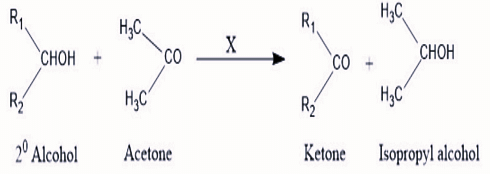Question:
Write short notes on the following:
(i) Claisen Reaction
(ii) Cannizzaro’s Reaction
(iii) Rosenmund’s Reaction
Write short notes on the following:
(i) Claisen Reaction
(ii) Cannizzaro’s Reaction
(iii) Rosenmund’s Reaction
(ii) Cannizzaro’s Reaction
(iii) Rosenmund’s Reaction
Show Hint
Claisen → condensation (C–C bond), Cannizzaro → disproportionation (no $\alpha$-H), Rosenmund → acyl chloride to aldehyde.
Updated On: Oct 7, 2025
Hide Solution
Verified By Collegedunia
Solution and Explanation
(i) Claisen Reaction:
The Claisen condensation is the reaction of two esters or one ester and another carbonyl compound in the presence of a strong base (like sodium ethoxide) to form a $\beta$-keto ester or a $\beta$-diketone.
\[ 2CH_3COOC_2H_5 \; \xrightarrow{NaOC_2H_5} \; CH_3COCH_2COOC_2H_5 + C_2H_5OH \] This reaction is important in C–C bond formation in organic synthesis. (ii) Cannizzaro’s Reaction:
Aldehydes without $\alpha$-hydrogen undergo self-oxidation and reduction (disproportionation) in the presence of concentrated alkali to form a primary alcohol and a carboxylate salt.
\[ 2HCHO \; \xrightarrow{Conc. NaOH} \; CH_3OH + HCOONa \] Example: Formaldehyde gives methanol and sodium formate. (iii) Rosenmund’s Reaction:
This reaction involves the hydrogenation of acid chlorides in the presence of palladium (Pd) catalyst on barium sulfate (BaSO$_4$) to produce aldehydes.
\[ RCOCl + H_2 \; \xrightarrow{Pd/BaSO_4} \; RCHO + HCl \] This method is used for the controlled synthesis of aldehydes from acyl chlorides. Conclusion:
Claisen reaction forms $\beta$-keto esters, Cannizzaro’s reaction converts aldehydes without $\alpha$-H into alcohols and acids, and Rosenmund’s reaction selectively reduces acyl chlorides to aldehydes.
The Claisen condensation is the reaction of two esters or one ester and another carbonyl compound in the presence of a strong base (like sodium ethoxide) to form a $\beta$-keto ester or a $\beta$-diketone.
\[ 2CH_3COOC_2H_5 \; \xrightarrow{NaOC_2H_5} \; CH_3COCH_2COOC_2H_5 + C_2H_5OH \] This reaction is important in C–C bond formation in organic synthesis. (ii) Cannizzaro’s Reaction:
Aldehydes without $\alpha$-hydrogen undergo self-oxidation and reduction (disproportionation) in the presence of concentrated alkali to form a primary alcohol and a carboxylate salt.
\[ 2HCHO \; \xrightarrow{Conc. NaOH} \; CH_3OH + HCOONa \] Example: Formaldehyde gives methanol and sodium formate. (iii) Rosenmund’s Reaction:
This reaction involves the hydrogenation of acid chlorides in the presence of palladium (Pd) catalyst on barium sulfate (BaSO$_4$) to produce aldehydes.
\[ RCOCl + H_2 \; \xrightarrow{Pd/BaSO_4} \; RCHO + HCl \] This method is used for the controlled synthesis of aldehydes from acyl chlorides. Conclusion:
Claisen reaction forms $\beta$-keto esters, Cannizzaro’s reaction converts aldehydes without $\alpha$-H into alcohols and acids, and Rosenmund’s reaction selectively reduces acyl chlorides to aldehydes.
Was this answer helpful?
0
0
Top Questions on carbonyl compounds
- Which of the following are neutral?
- KEAM - 2025
- Chemistry
- carbonyl compounds
- Acetone can be converted to 2-methylpropan-2-ol using:
- KEAM - 2025
- Chemistry
- carbonyl compounds
- The correct stability order of carbocations is
- JEE Main - 2024
- Chemistry
- carbonyl compounds
- According to Oppenauer Oxidation reaction, oxidation of secondary alcohol to ketone by reagent (X) in acetone takes place, what is "X" :

- GPAT - 2024
- Organic Chemistry
- carbonyl compounds
- The Gattermann-Koch reaction is used in the industrial preparation of benzaldehyde. The electrophile involved in this reaction is
- CUET (UG) - 2024
- Chemistry
- carbonyl compounds
View More Questions
Questions Asked in UP Board XII exam
- Change any one of the following into indirect narration:
(i) The General said to his soldiers, "March forward and kill the enemy."- UP Board XII - 2025
- Direct And Indirect Speech
- What do you understand by order of a reaction? Calculate the total order of those reactions which have velocity equations:
(i) Velocity \( = K[A]^{1/2}[B]^{3/2} \)
(ii) Velocity \( = K[A]^3[B]^{-1} \)- UP Board XII - 2025
- Order of reaction
- Find the maximum kinetic energy of the photo-electrons ejected, when light of wavelength 3300 Å is incident on a Cesium surface. Work function of Cesium = 1.9 eV.
- UP Board XII - 2025
- Photoelectric Effect
- Prove that the semi-vertical angle of a cone with given slant height and maximum volume is \( \tan^{-1}(\sqrt{2}) \).
- UP Board XII - 2025
- Mathematics
- What are different means of production and the rewards given to them?
- UP Board XII - 2025
- Economics
View More Questions